Analyzing Your Automobile'S Warning Indicators: What They Truly Share
Analyzing Your Automobile'S Warning Indicators: What They Truly Share
Blog Article
Short Article By-Hartley Kejser
When you lag the wheel, those beautiful caution lights on your control panel can be a little bit difficult. Do you recognize what they're trying to tell you concerning your cars and truck's health and wellness? Recognizing https://judahvqkfy.blogoscience.com/37356499/hesitant-regarding-choosing-a-vehicle-repair-shop-discover-specialist-pointers-for-discovering-dependable-alternatives-in-your-location-that-will-put-your-mind-secure of these lights is important for your safety and the long life of your lorry. So, the next time one of those lights appears, wouldn't you want to decode its message properly and take the required steps to resolve it?
Common Caution Lighting and Interpretations
Determine common warning lights in your auto and understand their definitions to make sure risk-free driving.
One of the most regular warning lights consist of the check engine light, which signals problems with the engine or exhausts system. If this light comes on, it's crucial to have your lorry examined promptly.
The oil stress advising light suggests reduced oil stress, needing prompt attention to prevent engine damages.
A blinking battery light might recommend a malfunctioning charging system, possibly leaving you stranded if not addressed.
The tire stress tracking system (TPMS) light alerts you to low tire pressure, impacting vehicle stability and fuel performance. Disregarding https://air-lift-performance39517.bloginder.com/31827201/discover-the-essential-actions-to-recognizing-a-trustworthy-vehicle-repair-shop-that-will-certainly-keep-your-auto-s-ideal-performance-your-lorry-deserves-remarkable-solution can result in risky driving problems.
The ABS light suggests a problem with the anti-lock braking system, endangering your capability to stop quickly in emergency situations.
Last but not least, the coolant temperature advising light warns of engine getting too hot, which can result in extreme damage if not settled quickly.
Recognizing these typical caution lights will help you attend to issues without delay and preserve safe driving problems.
Importance of Prompt Focus
Understanding the typical caution lights in your vehicle is only the primary step; the value of quickly addressing these cautions can not be stressed sufficient to guarantee your safety and security when driving.
When a warning light brightens on your control panel, it's your cars and truck's means of connecting a potential problem that requires interest. Ignoring these warnings can bring about much more serious issues down the road, jeopardizing your security and potentially costing you a lot more in repairs.
read this post here to alerting lights can prevent breakdowns and accidents. As an example, a flashing check engine light can suggest a misfire that, if left neglected, could trigger damage to the catalytic converter. Resolving this without delay can save you from a pricey repair service.
In a similar way, a brake system alerting light could signal reduced brake liquid or used brake pads, important components for your security when driving.
DIY Troubleshooting Tips
If you notice a warning light on your control panel, there are a few do it yourself troubleshooting ideas you can try prior to seeking specialist assistance.
The first step is to consult your car's manual to comprehend what the details warning light indicates. Sometimes car seat wash can be as simple as a loosened gas cap causing the check engine light. Tightening the gas cap may fix the issue.
Another typical concern is a low battery, which can set off numerous warning lights. Inspecting the battery connections for rust and guaranteeing they're safe and secure might fix the issue.
If a caution light continues, you can attempt resetting it by disconnecting the auto's battery for a few minutes and then reconnecting it. Additionally, checking your vehicle's fluid degrees, such as oil, coolant, and brake liquid, can help repair cautioning lights connected to these systems.
Conclusion
Finally, understanding your car's caution lights is vital for maintaining your vehicle running smoothly and safely. By immediately addressing these informs and recognizing what they indicate, you can avoid pricey repair work and prospective failures.
Keep in mind to consult your cars and truck's manual for specific information on each alerting light and take action accordingly to ensure a hassle-free driving experience.
Stay educated, remain safe on the road!
